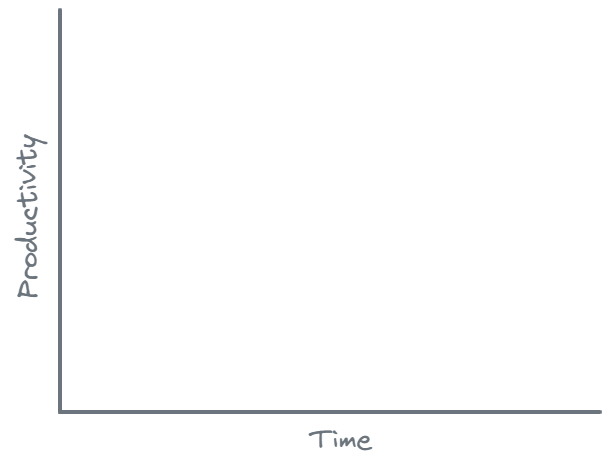- Bearly Thinking
- Posts
- What it's like working with ADHD
What it's like working with ADHD
A true double-edged sword, a superpower, a curse
I've been thinking a lot about productivity lately. Not in the online influencer-bro, cold-showers at 4:00 AM sense, but in the sense that I've gone from writing a grand total of 1 post in 2022 to writing what is my third in the first two weeks of January and I'm intrigued why this is the case/if it has anything to do with my anxieties and neuroses as a human.
But it wasn't until I saw this tweet that it clicked:

Imagine plotting your productivity over time onto a chart

For a normal person without ADHD, it may look something like this

Sure, you may have your peaks and troughs, but all in all over the course of a long enough span of time assuming no external changes to your habits, environment, etc, your productivity is relatively constant.
For someone with ADHD, it's very similar, except for one thing: magnitude
The core experience of someone with ADHD is very similar in nature to someone without it (at least in my experience), but the magnitude of the peaks and troughs is much larger. Days of endless productivity where I feel superhuman are punctuated by days of deep lethargy and an inability to do pretty much anything.

If you look closely enough, you'll see that the core shape of the ADHD curve is identical to the Non-ADHD, but blown up on the vertical axis. This is because the the excitement over closing a deal or the urgency created by a last-minute request on a tight deadline affect us directionally the same—but our brains release chemicals at different rates in response, causing us to prioritize and act differently.
In a vacuum, this would all be just fine for people with ADHD, because despite having more significant peaks and troughs, productivity over time averages out to the same value as non-ADHD havers. But we don't live in a vacuum.
The problem is that humans have a habit of setting their best as "normal"
For the average person, this means a down day can be a bit of a bummer. You compare your performance to what you know you could have given and you know it's not quite there, which is a bit of a bummer.
But for someone with ADHD, the comparison feels so much worse. What is otherwise a down day can easily become an inescapable pit of despair, fraught with fears that one will never reach their potential ever again.

Fortunately, there are a couple of solutions for people with ADHD thanks to modern medicine and advancements in psychology: namely stimulants and routine.
Stimulants can keep our productivity out of the pits, but they don't get us to the highs
Now, I think stimulants tend to get a bad rap in modern society. It's easy for people to think of Adderall and Ritalin as things for hyped up school kids and college sophomores cramming for finals. And don't get me wrong, the usage of stimulants should definitely be constrained to the people and occasions where it's necessary.
But stimulants offer a huge boost not just to productivity, but to one's mental health. This is achieved by (again, in my personal experience), helping cut out the bottom third of the chart.

In essence, stimulants can help to set a higher baseline that's more in tune with what the normal non-ADHD person experiences. Not only does this create a higher average productivity, but it also reduces the distance from the peak to the trough, limiting the size of one's perceived failure to measure up when productivity is low.
Habit and routine shorten time spent in the pits and get us back to the highs faster
But hey, stimulants aren't for everyone, which is why habit and routine are critical to staying productive and on target with ADHD.
Building strong habits and effective routines help by reducing the time spent in the pit of despair and getting us directed back toward productivity as quickly as possible. Not only does this result in higher average productivity, but it offers little time to sulk in the pits and bemoan one's lot in life.

One of the core issues with low-productivity days with ADHD is executive dysfunction. It's when every single task feels like the heaviest lift possible. Inertia reigns supreme and the word of the day is "bleh". Nothing sounds enjoyable and nothing feels doable.
Routine overcomes this by creating low-inertia defaults that get us back on track by easing us into a high-productivity mindset. Having a routine that is easy to start and making a habit out of performing said routine at typical low-productivity moments can create an easy solution to the "everything feels so difficult" rut that executive dysfunction creates.
There's no real conclusion here, but I'd love to hear your thoughts
This is less of an argument aimed toward some grand conclusion and more me trying to make sense of how my brain works by thinking about it in public. But I hope this has been illuminating and has shed some light on how (at least some) people with ADHD work through lapses in productivity and the mental health work that goes into getting back on track.
How was this post? |
Reply